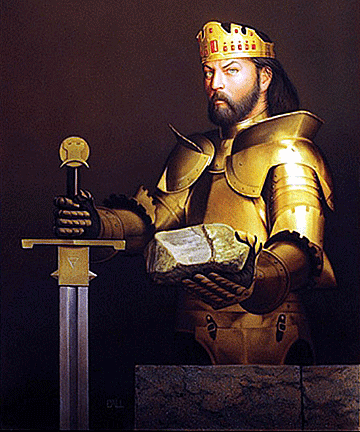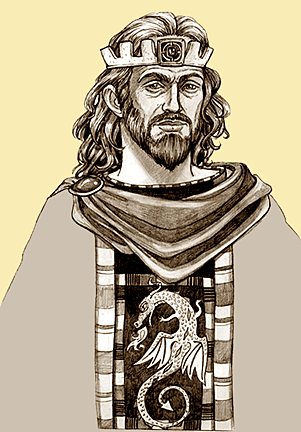|
 There's
a story that some like to think is true. During the 13th century, there was
an abbot speaking to a congregation of monks. Many of the monks had fallen
asleep. In desperation, the abbot raised his voice and declared: "I will
tell you something new and great. There was once a mighty king, whose name
was Arthur..." There's
a story that some like to think is true. During the 13th century, there was
an abbot speaking to a congregation of monks. Many of the monks had fallen
asleep. In desperation, the abbot raised his voice and declared: "I will
tell you something new and great. There was once a mighty king, whose name
was Arthur..."
Those words had an electrifying effect. Though the monks couldn't stay awake
to hear the abbot's thoughts on holy matters, they perked up at the mention
of the magical name: Arthur.
I, too, have that reaction, and so I traveled to England in search of the
real King Arthur. But if I didn't believe in the legend myself, I wouldn't
have been able to find anything, for there are no markers or monuments that
state categorically that he existed.
There's now general acceptance that behind the legendary figure of Arthur
stands a real historic personage—a great leader named Arturus, who
championed the Britons' resistance against the Anglo-Saxons in the 5th
century. However, his name doesn't appear on any reliable history of the
period—for it was truly the Dark Ages—and probably because the name Arturus
is a title meaning Bear.
Although the Saxons finally conquered Britain, the Celts remained strong in
some parts. In Cornwall, Cumberland, and Wales, the Celtic people retained a
degree of independence and kept alive the memory of old champions like
Arturus. Celtic bards never wrote anything down and traveled from court to
court recounting folk tales of the past. Over time, Arturus, the military
leader, became, in the legends, King Arthur of the English.
 It
wasn't until much later in the 12th century that the Historia Brittonum,
The History of the Britons, listed his battles against Germanic
invaders—the Saxons and the Angles—during the late 5th and early 6th
centuries, more than a century after the Roman legions departed. He was
successful for a time driving back the Saxons, only to die tragically in a
civil war after the Battle of Camlann in 537 A.D. Fifty years later, the
Saxons once again drove north and decimated the Britains. It
wasn't until much later in the 12th century that the Historia Brittonum,
The History of the Britons, listed his battles against Germanic
invaders—the Saxons and the Angles—during the late 5th and early 6th
centuries, more than a century after the Roman legions departed. He was
successful for a time driving back the Saxons, only to die tragically in a
civil war after the Battle of Camlann in 537 A.D. Fifty years later, the
Saxons once again drove north and decimated the Britains.
Historians believe Arthur was Dux (Duke) of the Britains, a Roman title.
However, in 500 A.D. such titles were becoming vague and the title of King
became the common accustomed designation of power. When Roman rule faded on
the island, the old kingly families of the tribes and regions re-emerged.
From his accession to power upon the death of this father, Ambrosius
Aurelianus, Duke of the Britains, sometime after 495, to his own death some
40 years later, there were four decades of struggles and triumphs. For the
Arthurian detective, this explains the myriad of places in Britain and Wales
that lay claim to the legendary king.
The 12th-century chronicler, Geoffrey of Monmouth, in his Historia Regum
Britanniae, History of the Kings of Britain, written in 1135, became the
source for a whole body of literature that created the legend of King
Arthur.
Later, in 1160, French writer Chretien de Troyes established King Arthur as
a fashionable subject of romantic literature by introducing medieval
chivalry and courtly romance. Not only did de Troyes create many of the
knights, including Sir Lancelot, he also used the more lyrical sounding
Guinevere as the name for Arthur's queen and chose Camelot for the name of
his court.
Next:
Le Mort D'Artur
|
